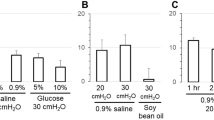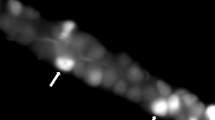Summary
The effects of carbonic anhydrase inhibitors on secretion by macropodine parotid and mandibular glands were investigated using anaesthetized red kangaroos. In the parotid gland, acetazolamide (500 μmol·l-1) reduced a stable acetylcholine-evoked, half-maximal flow rate of 2.02±0.034 to 0.27±0.023 ml·min-1 (87% reduction). Concurrently, salivary bicarbonate concentration and secretion fell (129.4±1.46 to 80.9±1.63 mmol·l-1 and 264.8±7.96 to 22.3±2.30 μmol·min-1, respectively), phosphate and chloride concentrations rose (14.0±0.79 to 27.6±0.85 mmol·l-1 and 5.6±0.25 to 27.5±1.32 mmol·l-1, respectively), sodium concentration and osmolality were unaltered, and potassium concentration fell (8.8±0.33 to 6.4±0.29 mmol·l-1). High-rate cholinergic stimulation during acetazolamide blockade was unable to increase salivary flow beyond 11±0.9% of that for equivalent unblocked control stimulation. However, superimposition of isoprenaline infusion on the acetylcholine stimulation caused a three-fold increase in the blocked flow rate. These treatments were accompanied by small increases in salivary phosphate and chloride concentrations but not bicarbonate concentration. Methazolamide infusion caused similar changes in parotid secretion. In the mandibular gland, acetazolamide infusion had no effect on salivary flow rate during either low- or high-level acetylcholine stimulation. Acetazolamide caused no alterrations in salivary electrolyte secretion at low flow rates, but curtailed the rise in bicarbonate concentration associated with high-level acetylcholine stimulation. Acetazolamide administration did not affect the increase in salivary flow rate associated with isoprenaline infusion, but did block the concomitant increase in bicarbonate concentration and secretion substantially. It was concluded that neither cholinergic nor adrenergic stimulation of mandibular fluid secretion depends on secretion of bicarbonate derived from catalysed hydration of CO2, but a substantial proportion of the increase in bicarbonate secretion during isoprenaline administration, which is probably ductal in origin, is so dependent. In contrast to other salivary glands, including the ovine parotid, fluid secretion by the kangaroo parotid gland during cholinergic stimulation is largely dependent (about 90%) on secretion of bicarbonate derived from hydration of CO2 catalysed by glandular carbonic anhydrase. Fluid secretion during adrenergic stimulation is not bicarbonate dependent.
Similar content being viewed by others
Abbreviations
- b.w.:
-
body weight
- PAH:
-
p-aminohippurate
- PCO2 :
-
partial pressure carbon dioxide
- PCO2 :
-
partial pressure of oxygen
References
Baginski ES, Foa PP, Zak B (1967) Microdetermination of inorganic phosphate, phospholipids, and total phosphate in biological materials. Clin Chem 13:326–332
Beal AM (1976) The effect of intravenous infusion of hyperosmotic sodium and potassium chloride solutions on cephalic blood flow in conscious sheep. Q J Exp Physiol 61:309–319
Beal AM (1979) Parotid salivary flow and composition during infusion of acetylcholine and atropine into the carotid artery of conscious sodium-replete sheep. Q J Exp Physiol 64:89–107
Beal AM (1984) Electrolyte composition of parotid saliva from sodium-replete red kangaroos (Macropus rufus). J Exp Biol 111:225–237
Beal AM (1986a) Responsiveness of the parotid salivary gland of red kangaroos (Macropus rufus) to mineralocorticoids. J Exp Biol 120:309–324
Beal AM (1986b) Effects of flow rate, duration of stimulation, and mineralocorticoids on the electrolyte concentrations of mandibular saliva from the red kangaroos (Macropus rufus). J Exp Biol 126:315–339
Beal AM (1989a) The effect of β-sympathomimetic stimulation on parotid salivation in red kangaroos (Macropus rufus). Arch Oral Biol 34:355–363
Beal AM (1989b) Secretion by the mandibular gland of the red kangaroo (Macropus rufus) during isoprenaline infusion. J Comp Physiol B 159:601–608
Blair-West JR, Coghlan JP, Denton DA, Nelson JF, Orchard E, Scoggins BA, Wright RD, Myers K, Junqueira CL (1968) Physiological, morphological, and behavioural adaptation to a sodium-deficient environment by wild native Australian and introduced species of animals. Nature 217:922–928
Blair-West JR, Fernley RT, Nelson JF, Wintour EM, Wright RD (1980) The effect of carbonic anhydrase inhibitors on the anionic composition of sheep's parotid saliva. J Physiol (Lond) 299:29–44
Bruzilow SW, Diaz CL (1962) Effect of acetazolamide on dog parotid saliva. Am J Physiol 202:158–160
Case RM, Conigrave AD, Novak I, Young JA (1980) Electrolyte and protein secretion by the perfused rabbit mandibular gland stimulated with acetylcholine or catecholamines. J Physiol (Lond) 300:467–487
Case RM, Conigrave AD, Favaloro EJ, Novak I, Thompson CH, Young JA (1982) The role of buffer anions and protons in secretion by the rabbit mandibular gland. J Physiol (Lond) 322:273–286
Chauney HH, Weiss PA (1958) Composition of human saliva. Parotid gland secretion: flow rate, pH and inorganic composition after oral administration of a carbonic anhydrase inhibitor. Arch Int Pharmacodyn Ther 113:377–383
Coats DA, Wright RD (1957) Secretion by the parotid gland of the sheep: the relationship between salivary flow and composition. J Physiol (Lond) 131:611–622
Fernley RT, Wright RD, Coghlan JP (1979) A novel carbonic anhydrase from the ovine parotid gland. FEBS Lett 105:299–302
Gyory AZ, Edwards KDG (1967) Simultaneous titrimetric determination of bicarbonate and titratable acid in urine. Austr J Exp Biol Med Sci 45:141–147
Katz ML, Bergman EN (1969) Simultaneous measurements of hepatic and portal venous blood flow in the sheep and dog. Am J Physiol (Lond) 216:946–952
Leder O, Tritschler P (1966) Nachweis höchster Carboanhydrase-Aktivitäten im Epithel der Speicheldrüsengänge. Pflügers Arch 292:229–238
Martin CJ, Young JA (1971) A microperfusion investigation of the effects of a sympathomimetic and a parasympathomimetic drug on water and electrolyte fluxes in the main duct of the rat submaxillary gland. Pflügers Arch 327:303–323
Maren TH (1967) Carbonic anhydrase: chemistry, physiology and inhibition. Physiol Rev 47:595–781
Maren TH (1977) Use of inhibitors in physiological studies of carbonic anhydrase. Am J Physiol 232:F291–297
Morris GCR, Swayne GW (1964) Histochemical studies of carbonic anhydrase in the salivary glands of rabbits. J Physiol (Lond) 171:5–6P
Niedermeier W, Stone RE, Dreizen S, Spies TD (1955) Effect of 2-acetylamino-1,3,4-thiadiazole-5-sulfonamide (Diamox) on sodium, potassium, bicarbonate, and buffer content of saliva. Proc Soc Exp Biol Med 88:273–275
Pirani D, Evans LAR, Cook DI, Young JA (1987) Intracellular pH in the rat mandibular salivary gland: the role of Na−H and Cl−HCO3 antiports in secretion. Pflügers Arch 408:178–184
Pitts RF (1963) Physiology of the kidney and body fluids. Year Book Medical Publishers, Chicago, p 165
Porter BD (1981) The structure and function of macropodid salivary glands. PhD thesis, University of New South Wales, Australia, p 35
Rector FC Jr (1973) Acidification of the urine. In: Orloff J, Berliner RW (eds) Handbook of physiology, section 8, Renal physiology. American Physiological Society, Washington DC, pp 431–454
Seldinger SI (1953) Catheter replacement of the needle in percutaneous arteriography. Acta Radiol 39:368–376
Smith HW, Finkelstein N, Aliminosa L, Crawford B, Graber M (1945) Renal clearances of substituted hippuric acid derivatives and other aromatics in man. J Clin Invest 24:388–404
Somner HM, Kaiser D, Drack E (1975) pH and bicarbonate excretion in the rat parotid gland as a function of salivary rate. Pflügers Arch 355:353–360
Steel RDG, Torrie JH (1960) Principles and procedures in statistics. McGraw-Hill, New York, pp 109–110
van Goor H (1948) Carbonic anhydrase, its properties, distribution, and significance for carbon dioxide transport. Enzymologia 14:73–164
Wright RD, Blair-West JR, Nelson JF (1986) Effects of ouabain, amiloride, monensin, and other agents on ovine parotid secretion. Am J Physiol 250:F503-F510
Yoshimura H, Iwasaki H, Nishikawa T, Matsumoto S (1959) Role of carbonic anhydrase in the bicarbonate excretion from salivary glands and the mechanism of ionic excretion. Jpn J Physiol 9:106–123
Young JA, Martin CA, Asz M, Weber FD (1970) A microperfusion investigation of bicarbonate secretion by the rat submaxillary gland. Pflügers Arch 319:185–199
Young JA, Martin CJ (1971) The effect of a sympatho- and a parasympathomimetic drug on the electrolyte concentrations of primary and final saliva of the rat submaxillary gland. Pflügers Arch 327:285–302
Young JA, van Lennep EW (1978) The morphology of salivary glands. Academic Press, London New York San Francisco, p 39
Young JA (1979) Salivary secretion of inorganic electrolytes. In: Crane RK (ed) Gastrointestinal physiology III, International review of physiology, vol 19. University Park Press, Baltimore
Young JA, Schneyer CA (1981) Composition of saliva in mammalia. Aust J Exp Biol Med Sci 59:1–53
Author information
Authors and Affiliations
Rights and permissions
About this article
Cite this article
Beal, A.M. The effect of carbonic anhydrase inhibitors on secretion by the parotid and mandibular glands of red kangaroos Macropus rufus . J Comp Physiol B 161, 611–619 (1991). https://doi.org/10.1007/BF00260752
Accepted:
Issue Date:
DOI: https://doi.org/10.1007/BF00260752




